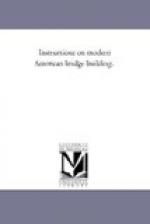TABLE OF SAFE WORKING LOAD IN LBS., FOR HOLLOW CAST-IRON COLUMNS.
[G.L. Vose.]
Outside Length or height in Feet Metal Diameter Thickness in inches. 6 8 10 12 15 18 20 in inches.
3 16000 14000 13000 11000 9000 7000 6000 3/8 4 30000 29000 26000 24000 22000 18000 16000 1/2 5 50000 37000 45000 42000 39000 37000 31000 5/8 6 59000 57000 55000 52000 49000 44000 41000 3/4 7 101000 99000 96000 92000 88000 81000 76000 13/16 8 131000 129000 126000 122000 118000 109000 105000 7/8 9 169000 167000 164000 160000 156000 146000 141000 1 10 210000 200000 200000 200000 190000 180000 180000 1-1/8 11 250000 250000 240000 240000 240000 230000 220000 1-1/4 12 300000 300000 290000 290000 290000 270000 270000 1-1/2 14 450000 430000 410000 380000 370000 350000 330000 1-3/4 16 520000 500000 480000 460000 440000 420000 400000 2 18 650000 630000 610000 590000 560000 520000 470000 2-1/2 20 800000 760000 740000 690009 650000 590000 540000 3
[Illustration: Pl. IV. with Fig. 1., Fig. 2., Fig. 3., Fig. 4.]
Transcriber’s Notes:
DISCLAIMER: This document should NOT be used to engineer any bridge projects! Many typesetting errors were found, and it is possible that there are further errors in the information that were not caught.
Formulas have been provided both as ASCII and TeX following in brackets. Bold headings are handled with equal signs before and after the bold text. Italicised text uses the standard underlines before and after the text. Fractions are expressed in the format: 2-1/4 means two and one quarter.
The page numbers listed below are project page numbers.
(The original book used Roman numerals to number the
pages.)
Note that the book uses the “long” ton equal to 2,240 pounds.
CORRECTIONS MADE:
1. Page 8—the formula
for “d” must use a cube root, which is
how it
is shown here,
but the ‘3’ to indicate a cube root is
not found in
the original document.
2. Page 8—typo in
word ’sectien’—changed to ‘section’.
3. Page 10—Value
for working comp. strength of cast iron in the
table had a typo




